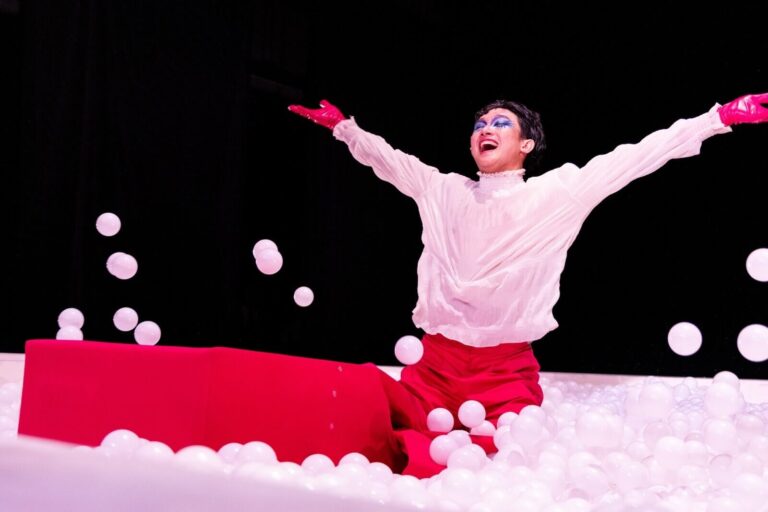作者:喜瑞(臺灣大學戲劇學系交換學生)
Author: Cyril Jean-Baptiste Paul Bizien (Exchange student of the Department of Drama and Theatre at NTU)
作品:臺大戲劇學系第二十二屆畢業製作劇展《偽君子》
演出:臺灣大學戲劇學系
時間:2024/05/04 14:30
地點:臺灣大學藝文中心遊心劇場
Play: “Tartuffe” The 22nd Grad Production by the Department of Drama and Theatre at NTU
Team: The Department of Drama and Theatre at NTU
Time:2024/05/04 14:30
Location: Player Theatre, NTU Center for the Arts
編按:本次《偽君子》的演出評論邀請來自法國的戲劇系交換學生Cyril喜瑞撰寫,他對法國劇場及原著Tartuffe有深刻的認識,在本篇評論中,喜瑞先向讀者介紹Tartuffe在法國上演的背景,說明「Tartuffe」這個詞從劇名變成法國通用的詞彙,更在1694年被收錄於法語權威字典《法蘭西學術院字典》,可見其社會影響力。接著,他分析臺大戲劇學系畢製《偽君子》如何透過影像、服裝、舞台等劇場設計,來加強劇中重要的偽裝、扮演概念,並從角色的行為及彼此的互動方式,探討人物溝通及表達自我的能與不能。整體而言,喜瑞認為這次的製作tartuffy(tartuffe化)了Tartuffe這個劇本,完整的評論請見英文正文。
Understanding the impact of Molière’s Tartuffe at the time of its creation is essential for an effective representation. This influence can be measured by focusing on two crucial events. Tartuffe, the Hypocrite, as it was called in its first version, was censored only two days after its premiere by the monarchy, under the guidance of the archbishop of Paris who accused the playwright of mocking devout Catholics. To be forbidden in the country after one staging, taking place at Louis XIV’s court in Versailles, is significant evidence that the comedy had upset some of its early powerful spectators, who felt directly targeted by the buffoonery they saw that day. Despite this, the production resumed five years later and ultimately became one of Molière’s defining successes.
The second and, perhaps, most telling consequence of the play in the seventeenth century is the inclusion of the noun and adjective “tartuffe” in Le Dictionnaire de l’Académie française in 1694, by the highest authority on French language. The word was already used prior to this formal recognition but the antonomasia is nonetheless a testimony to the immediate rise in popularity brought forth by the play. Thanks to these two ramifications, it appears evident that the play served as a strong satire denouncing part of its own audience, as well as an important segment of the contemporary society. In some ways, the Department of Drama and Theatre at NTU’s production of Tartuffe went a step further, transforming it into a theater of hypocrisy.
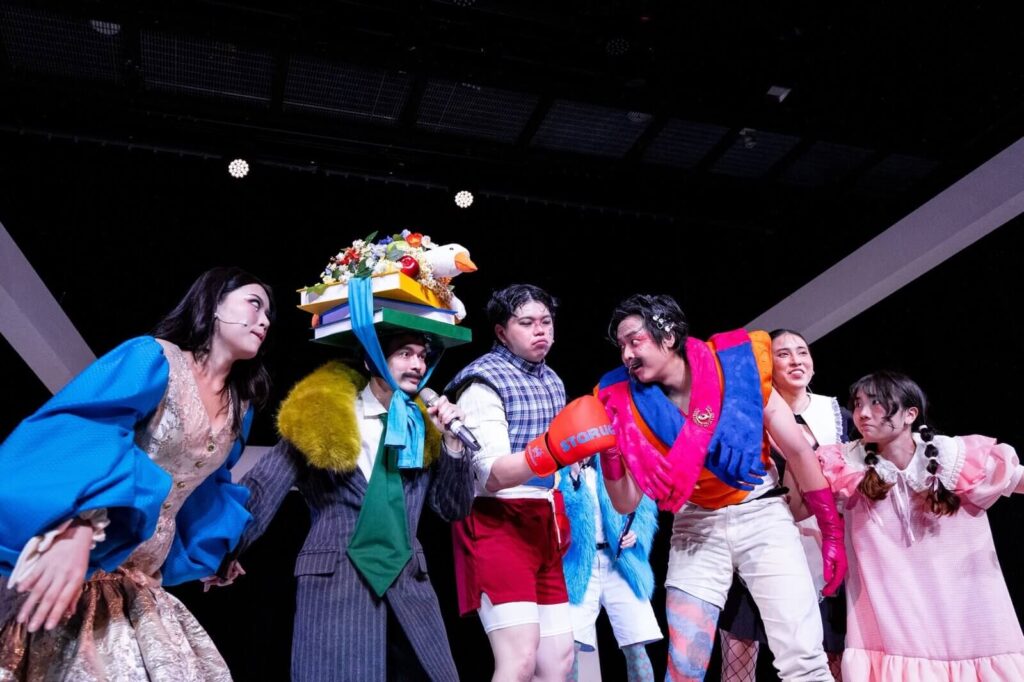
And what better medium than a screen to appear as what you are not? If the four monitors (two on each side of the scene), haphazardly gleaning images of the characters’ lives while they’re not on stage, certainly come to mind, there is a fifth and final one in the form of the set itself. An all-encompassing and hollow white structure, shaped like the edges of a trapezoidal prism, is facing the audience, akin to the skeleton of a cathode-ray tube (CRT) television where images are modified and amplified before being projected to the viewers. Its base is transformed into a shallow white ball pool and is the main stage for the dramatic action. The entire scenic device resembles the set of a reality TV show where the family-contestant is constantly observed and judged. The public, responsible for its own gaze, can watch their most private instants on the lateral panels, whether they are sitting on the toilet, training with a punching bag or praying.
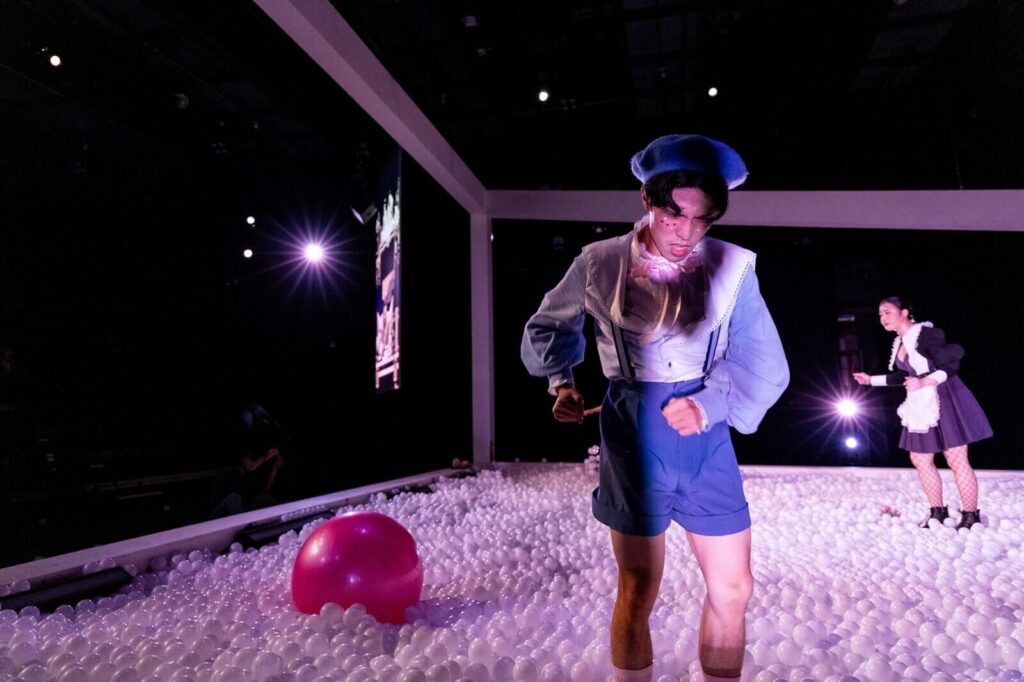
Before their appearances on stage, some characters even have makeup sessions that can be viewed, suggesting they are aware of the show they are a part of. On stage, Dorine, the family’s maid and Cléante, the uncle, are directly breaking the fourth wall, addressing the audience and the maid even goes as far as to mention actions that are occurring on the lateral screens. The underlying facade of theater’s fake reality becomes unmistakable, making it difficult to trust what one sees or discern whom to trust among the characters.
From the moment they step onto the main stage, the characters’ obsession with appearances becomes apparent. They all don exuberant clothes with bold color patterns and defining accessories, personas that inform the world around them as well as the audience about how they are and how they wish to be perceived. The costumes of Valère and Marianne are exhibiting the same pastel blue and pastel pink, automatically linking them together, as if there was an agreement upon their attire between the two lovers. Madame Pernelle, the grandmother, wears a bright red dress, with vivid blue polka dots, that covers her head, probably obstructing her from hearing her family’s pleas for help. She constantly brandishes a fly swatter, to inflict punishment and maintain discipline, albeit with very questionable effectiveness, and is adorned with three pearl necklaces around her head, crowning her as a quasi-religious figure. Orgon has comically oversized and pointed shoulder pads. Damis wears red boxing gloves. Marianne, like her mother, is encased in a corset.

However, when a piece of the costume falls so does a piece of their persona. Marianne is freed from the corset and the yoke of her father. Damis loses the gloves and starts crying. Pernelle removes her hood and can finally hear the laments. In her black and white outfit, Dorine is the only main character who doesn’t undergo a physical transformation as a result of the events occurring on stage. Unlike the others, she wears her suit because she is forced to, according to her role. She does not hide behind the fabric’s vivid colors to pretend to be something she is not. In a world where everything is Tartuffe, Dorine might just be a tart, due only to her sometimes exaggerated sweetness.
Ah. And Tartuffe?
His image is always at the center of the plot. He is described profusely before ever appearing on stage. We see him, on the lateral monitors, either oneirically strolling in slow motion while Orgon sings his praise to Cléante, or mischievously eating the Guai Guai supposed to be a part of a religious offering when someone is badmouthing him. He wears a bright pink square-shape costume that covers his ears, similarly to Madame Pernelle, but until he is given the baseball bat toy by Orgon – a childish representation of the ownership of the house as well as a phallic symbol of men’s make-believe authority – he doesn’t hold power. The impression he makes is, as for anyone else, often out of his control: despite Tartuffe having no motive to instill fear, his first stage entrance is accompanied by Prokofiev’s ominous Dance of the Knights. The only moment his outer aura is in adequacy with his inner character is when he is with the object of his love. Here, the music becomes calm and romantic and Tartuffe manages to come out of his rose shell, revealing a pristine white blouse.
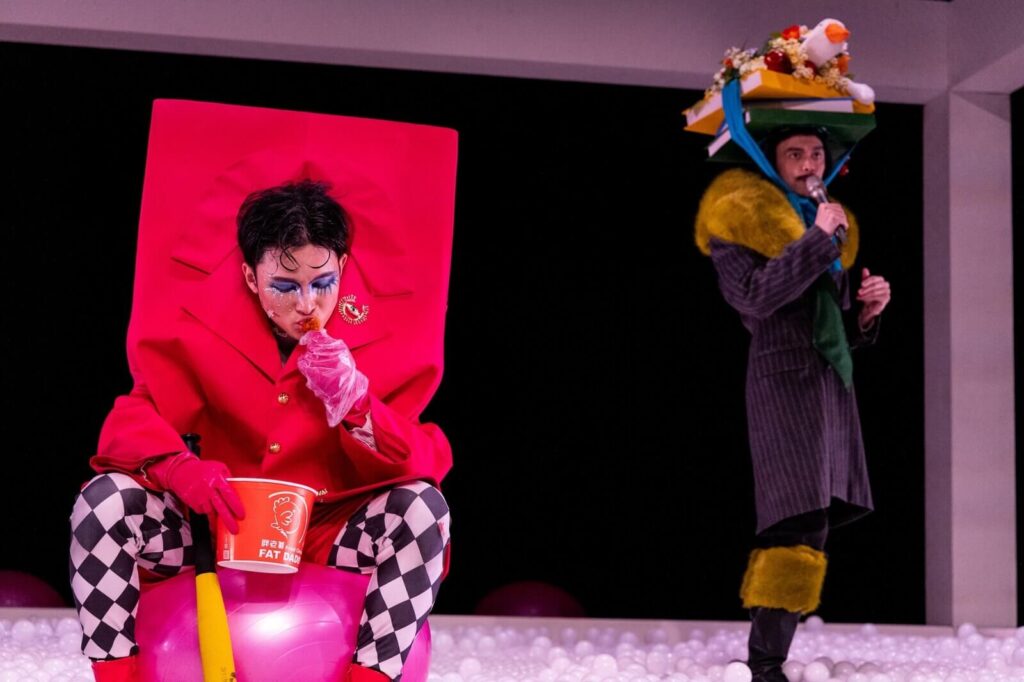
However, as with every other true communication attempt on stage, it turns into a childish and ridiculous game. The white ball pool, main stage of the play, renders even a normal step comical as the balls makes any move difficult and are often leaking through its sides. Marianne dances as she pretends to dislike Valère, Damis beats on pink beach balls when Orgon doesn’t believe him and Tartuffe places his newly acquired bat in a certain place to mimic a certain body part to seduce Elmire. Being used to interact with another’s forged virtual presence, it becomes impossible to act properly with his true self. Even the deus ex machina of the royal agent, saving Orgon’s family from ruin and allowing the happy ending of Valère and Marianne’s wedding, doesn’t solve this issue and Tartuffe, now prisoner of the king, understands it. He goes out of stage from the back curtain, revealing the backstage area where the marriage we see on the screens is supposedly happening, but it’s empty.
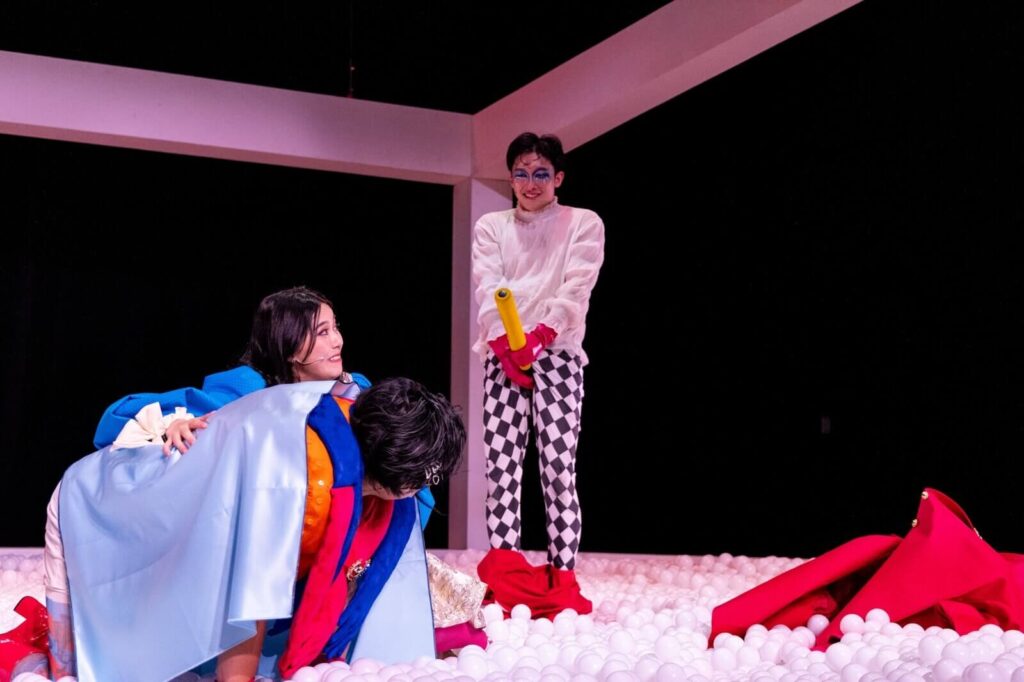
(攝影:airf.z 照片提供:臺大戲劇學系製作)
After the round of applause, when the spectators walk along the front of the stage to leave, they need to sidestep the white balls that spilled from the stage onto the rest of the room. The difficulties to communicate and to reveal each other’s true self have made their way to us. Are we all Tartuffe now?
Note:
The word “tartuffy” in the title is a transitive verb that doesn’t exist. The author, Cyril, created it using the suffix “-fy”, as in modify, petrify or liquefy. It’s clear that it expresses a process of transformation, meaning to make something more tartuffe.
責任編輯:陳明緯
審稿:李亭萱
關於作者
-
Exchange student of the Department of Drama and Theatre at NTU.
View all posts

